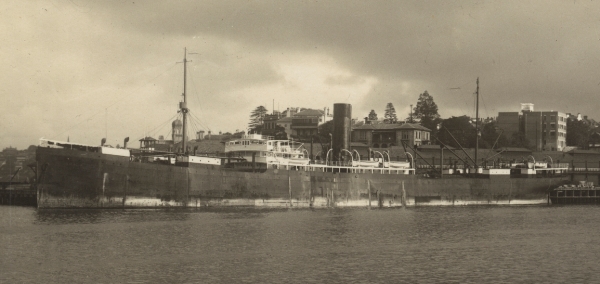Ernani
Italian Steam merchant

Ernani under her former name Valacia. Photo courtesy of State Library of New South Wales
| Name | Ernani | ||
| Type: | Steam merchant | ||
| Tonnage | 6,619 tons | ||
| Completed | 1910 - Russell & Co, Port Glasgow | ||
| Owner | Ditta Giovanni Gavarone fu Giovanni, Genoa | ||
| Homeport | Genoa | ||
| Date of attack | 29 Jun 1941 | Nationality: | |
| Fate | Sunk by U-103 (Viktor Schütze) | ||
| Position | 27° 52'N, 26° 17'W - Grid DG 9541 | ||
| Complement | 34 (2 dead and 32 survivors). | ||
| Convoy | |||
| Route | Las Palmas, Canary Islands (25 Jun) – Bordeaux | ||
| Cargo | Scrap iron | ||
| History | Completed in October 1910 as British Luceric for Bank Line Ltd (Andrew Weir & Co), Glasgow. 1916 renamed Valacia for Cunard White Star Ltd, Liverpool. 1931 sold to Italy and renamed Ernani for Industrie Navali Società Anonima (INSA), Genoa. 1938 sold to Ditta Giovanni Gavarone fu Giovanni, Genoa. On 10 Jun 1940, the ship was interned at Las Palmas, Canary Islands. | ||
| Notes on event | At 00.51 hours on 29 June 1941, U-103 fired its last torpedo at an unescorted steamer of 6600 GRT, observed a hit in the engine room and the subsequent sinking of the ship about 450 miles west of the Canary Islands. The steamer had been spotted at 16.42 hours the day before and was missed with a stern torpedo at 23.28 hours. After the sinking, the U-boat approached the lifeboats and Schütze questioned some survivors but he did not believe them when they told him that they were from the Italian steamer Ernani en route from Las Palmas to Horta, because the course of the ship didn’t correspond with the mentioned destination. In fact, the U-boat had sunk the Italian blockade runner Ernani (Master Guglielmo Rastelli), disguised as the Dutch steam merchant Enggano. She was the ninth and last Italian merchant ship that left the Canary Islands to run the blockade in an attempt to reach a French port (only five managed to reach their destination) and planned to arrive at Bordeaux between 9 and 11 August. Her crew began to disguise the ship only after leaving Las Palmas and they built a fake crow’s nest on a mast and additional bulwarks, removed the other mast and painted the hull and funnel black, but the work was not yet completed when the ship was torpedoed. The torpedo struck on the starboard side between the engine room and #4 hold and opened a large hole, causing the ship to sink by the stern within four minutes. Two crew members on watch below were killed, while the remaining crew members had barely time to abandon ship in both port lifeboats because both boats on the starboard side had been destroyed. As the Germans questioned the Italians in English, the master thought that they had been sunk by a British submarine, lied about the port of destination and asked for help. He was told that they couldn’t help them in any way but promised to send a radio message after leaving the area as no distress signal had been sent. The lifeboats unsuccessfully searched the area for the two missing men until midnight and then began to row and sail towards the nearest land. On 10 July, the weather deteriorated and the boats were tossed around violently by strong wind and heavy seas. The lifeboat in charge of the first officer began leaking during the storm and had to be abandoned eventually. Its occupants were taken aboard the other lifeboat which was in charge of the master. Around noon on 12 July, the exhausted survivors made landfall near Fuencaliente Lighthouse on La Palma, Canary Islands. The sinking of Ernani was investigated by the BdU after the Italian Navy protested, but no reason was found to blame Schütze for this mistake as he had not been informed about the presence of a friendly ship in the area and could not recognize the ship correctly as her appearance had been altered. | ||
| On board | We have details of 3 people who were on board. | ||
If you can help us with any additional information on this vessel then please contact us.
